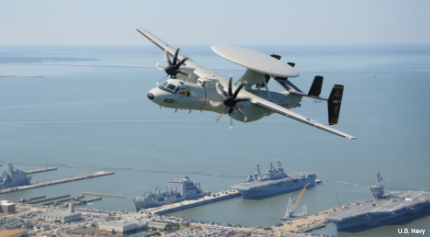Navy’s new airborne command and control post arrives
The E-2D Advanced Hawkeye is a key to network-centric battle groups.

The Navy’s most advanced, networked command and control aircraft has reported for duty with the Airborne Early Warning Squadron 125 (VAW-125) during at Naval Station Norfolk.
The E-2D Advanced Hawkeye, the latest version of the original E2 Hawkeye early warning aircraft that got its start in the late 1950s, has state-of-the-art radar and a variety of sensors in a networked open architecture that allows it to manage multiple missions during a single flight.
"This is a revolutionary jump in capabilities," Capt. Todd Watkins, commander of VAW-125’s Airborne Command Control and Logistics Wing, said in an announcement. "The E-2D serves as the eyes of the fleet. If it's out there, we will see it."
The E-2D is seen as key to network-centric battle groups. Its sensors and networking capabilities will provide a level of situational awareness to help carry out missions, adapt to changes in a mission and keep ships out of harm’s way, according to E2-D maker Northrop Grumman.
Among the aircraft’s feature are an advanced “friend or foe” identification system, new mission computer and tactical workstations, enhanced electronic support and modernized communications and data link suite.
The E-2D has true 360-degree radar coverage that represents a two-generation jump in radar capabilities, Northrop said, and its commercial, open-architecture hardware and software will enable quick, inexpensive refresh of components.
The VAW-125 is the first Navy squadron to go fully operational with the Advanced Hawkeye.



